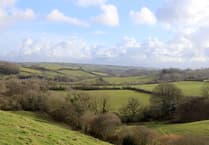WIMBLEBALL Lake, on Exmoor, was this week less than half-full – and South West Water warned it could be just weeks away from imposing water usage restrictions for the first time in 26 years.
The latest figures showed Wimbleball, which can hold 21.5 million litres of water, was only 45.7 per cent full, while across the region the SWW’s five main reservoirs collectively were 49.4 per cent of capacity.
Two other West Somerset reservoirs, Clatworthy, near Huish Champflower, and Hawkridge, near Over Stowey, both owned by Wessex Water, were said to be currently around half full, which a spokesman said was ‘no cause for concern for this time of year’.
SWW spokeswoman Beth Slow told the Free Press: “We continue to experience an unprecedented and prolonged period of hot and dry weather, alongside extremely high levels of demand. If the exceptional levels of demand and sustained dry weather continues we may have to make the difficult decision to introduce formal restrictions over the coming weeks to limit the pressure on resources and to protect the environment.
“We are sharing water saving tips and advice with customers and urging everyone to think carefully about their water usage.”
She said SWW would continue to review its position and keep customers fully informed.
Wimbleball and the River Exe directly provide water to around 220,000 people in the Tiverton, Exeter, and East Devon areas.
Water from Wimbleball is also pumped to Clatworthy to supply homes in other parts of Somerset. Water transfers can also be made to the Roadford reservoir, between Launceston and Okehampton, which supplies Plymouth and North and South West Devon.
The last water restrictions imposed by SWW were in 1996, but the West Country has just experienced its driest July for more than 100 years and the driest eight-month period from November, 2021, to June, 2022, since the infamous drought year of 1976.
SWW also said at the end of July it had seen water demand soar by 77 million litres in a single day, which was the equivalent of supplying three cities the size of Exeter.
The company’s drought plan, which all water firms were required to prepare, has three levels of response to a worsening situation.
Level one would see customers asked to cut their water usage, and an increased focus on repairing leaks. Level two would mean a temporary ban on hosepipes. The third level would escalate the ban to non-essential uses, and ‘all possible actions’ to avoid emergency drought orders. Level three would only be considered if conditions became worse than in 1976.
Wessex Water said the roughly 50 per cent levels of Clatworthy and Hawkridge were well above this time of the year in 1976 when the levels were just below 30 per cent full and around 35 per cent, respectively.
Wessex spokesman George Keast said: “There are no supply problems in the Wessex Water region but we always encourage our customers to use water responsibly for the benefit of everyone and the environment.”
He said although reservoir and ground water levels were below average, it was nothing unusual for the time of year and there were currently no supply issues and no prospect of a hosepipe ban in the region. If the situation was to become much worse and a reservoir was at risk of running dry, the company was able to move water around the region using its water supply grid network, he added.




